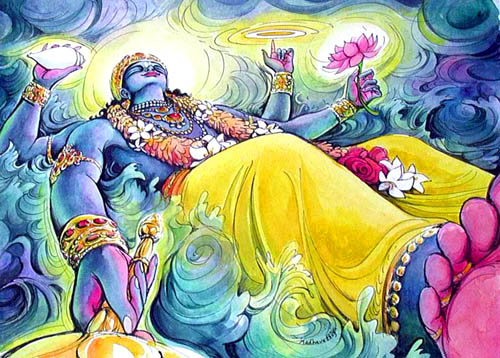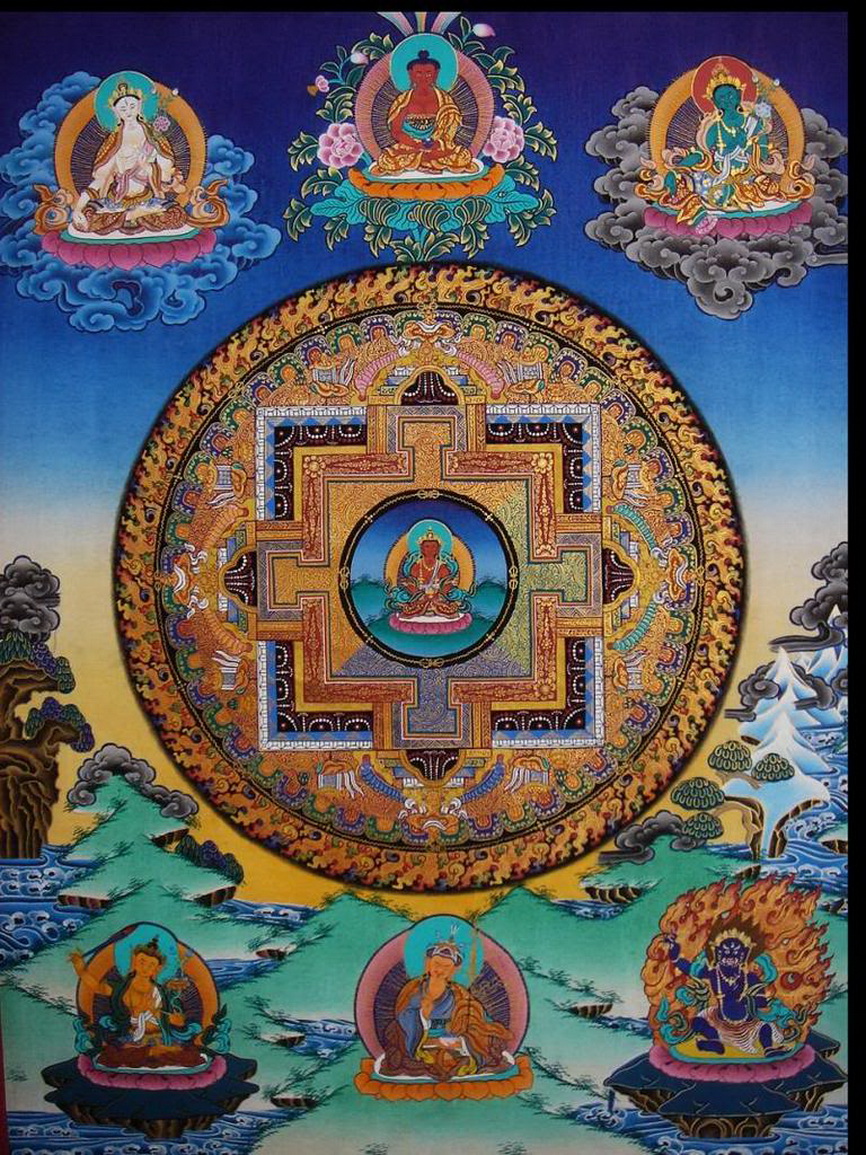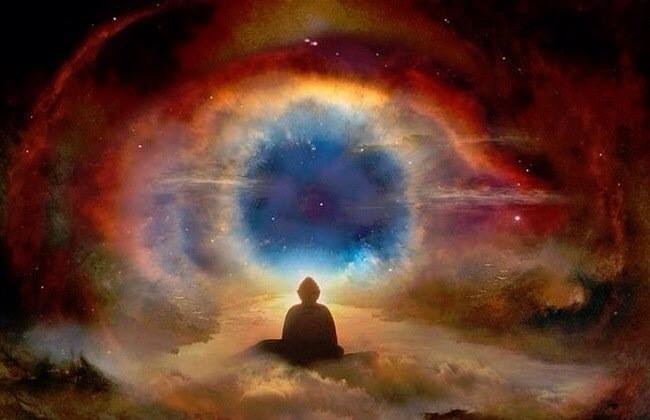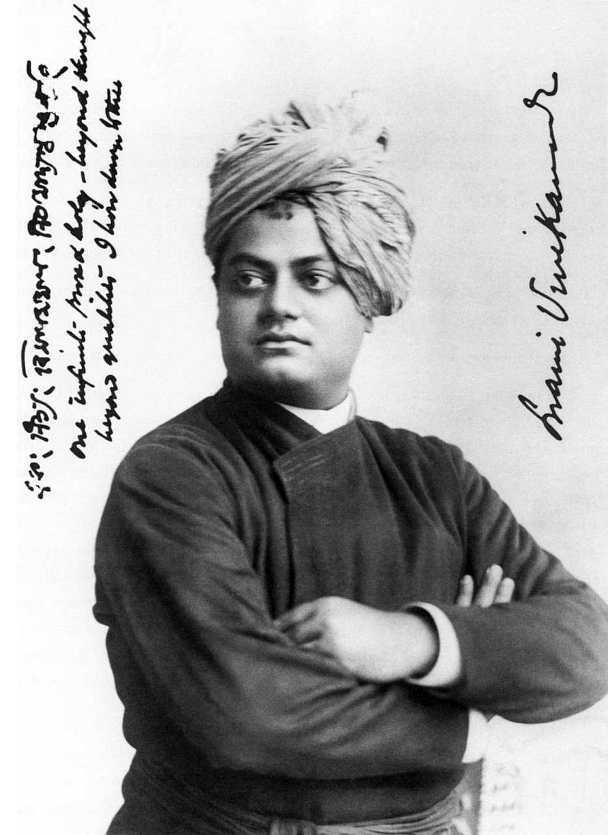Vedic Cosmological Narratives (Part II)
The Hymn of Purusha: God Takes Shape[1]
While the preceding passage from the Rig Veda contains some of the root kernel philosophical elements of Vedic philosophy, there is another passage from the same collection of hymns dating back to the 2nd millennium BCE that speaks to the more what we might call, classically ancient mythological, bent of the Indo-Aryans. This is a verse (quoted below) which describes a variation on the creation story/narrative which comes much closer to what we would call “myth”, and has a much more anthropomorphic bent, than the esoteric passage quoted above.
1 A THOUSAND heads hath Puruṣa, a thousand eyes, a thousand feet.
On every side pervading earth he fills a space ten fingers wide.
2 This Puruṣa is all that yet hath been and all that is to be;
The Lord of Immortality which waxes greater still by food.
3 So mighty is his greatness; yea, greater than this is Puruṣa.
All creatures are one-fourth of him, three-fourths eternal life in heaven.
4 With three-fourths Puruṣa went up: one-fourth of him again was here.
Thence he strode out to every side over what eats not and what eats.
5 From him Virāj was born; again Puruṣa from Virāj was born.
As soon as he was born he spread eastward and westward o’er the earth.
6 When Gods prepared the sacrifice with Puruṣa as their offering,
Its oil was spring, the holy gift was autumn; summer was the wood.
7 They balmed as victim on the grass Puruṣa born in earliest time.
With him the Deities and all Sādhyas and Ṛṣis sacrificed.
8 From that great general sacrifice the dripping fat was gathered up.
He formed the creatures of-the air, and animals both wild and tame.
9 From that great general sacrifice Ṛcas and Sāma-hymns were born:
Therefrom were spells and charms produced; the Yajus had its birth from it.
10 From it were horses born, from it all cattle with two rows of teeth:
From it were generated kine, from it the goats and sheep were born.
11 When they divided Puruṣa how many portions did they make?
What do they call his mouth, his arms? What do they call his thighs and feet?
12 The Brahman was his mouth, of both his arms was the Rājanya made.
His thighs became the Vaiśya, from his feet the Śūdra was produced.
13 The Moon was gendered from his mind, and from his eye the Sun had birth;
Indra and Agni from his mouth were born, and Vāyu from his breath.
14 Forth from his navel came mid-air the sky was fashioned from his head
Earth from his feet, and from his car the regions. Thus they formed the worlds.
15 Seven fencing-sticks had he, thrice seven layers of fuel were prepared,
When the Gods, offering sacrifice, bound, as their victim, Puruṣa.
16 Gods, sacrificing, sacrificed the victim these were the earliest holy ordinances.
The Mighty Ones attained the height of heaven, there where the Sādhyas, Gods of old, are dwelling.[2]
Here we see many of the basic, core elements of ancient creation mythology that we are familiar with in the West – the creation of the seasons, animals, anthropomorphism, etc. We also see a connection drawn from the creation cosmology to societal and theological structure, i.e. the caste system which was such a key component of the Indo-Aryan peoples for much of their history, and the connection between hymn and scripture and the godhead himself. We also see the creation of the astral and celestial elements such as the Earth, Sun and Moon and Sky, as well as the emergence of the first pantheon of Gods such as Indra, Vayu and Agni, both elements that are found in creation mythology throughout antiquity (the Greeks, the Romans, etc.).
Furthermore, this ancient primordial pseudo-anthropological principal – Purusha – evolved over time to become an integral part of two of the main Vedic philosophical systems, namely Samkhya and Yoga, each of which held universal creation to be a balance between two primordial forces – Purusha and Prakriti – male and female, inactive and active respectively, sharing many basic elements with Taoism (Yin/Yang) which emerged independently (presumably) in the Far East. So again we see the roots of the core Vedic and Hindu philosophical elements in the very earliest cosmological narrative, speaking to the duration and strength of the lineage itself and the strong connection between the cosmological narrative and the philosophy – brothers in arms as it were.
Manu, the Cosmic Egg and Dharma
We also find a very detailed account of creation in a very influential socio-political work from India called The Laws of Manu – aka Manusmriti – a work reflecting the latter part of the 2nd millennium BCE to the middle of the first millennium BCE (roughly running parallel with the transcription of the early Upanishads) dealing with social and cultural issues – laws, practices, customs, etc. – rather than ritual or mythical traditions as were codified in the Vedas and Upanishads. In it Manu, the mythical Adam of the Indo-Aryans, lays out the social philosophical principals and practices to a group of great sages (rishis), providing the guiding principals that were to underpin the governing of Indo-Aryan society for millennia.
Although not considered part of the orthodox Vedic scriptural tradition per se, the text is nonetheless extremely influential in the development of Indo-Aryan civilization, and Indian history in particular, as it lays the groundwork for the operation and management of a healthy society. The work may be looked at in contrast, or similar to Plato’s Republic or Aristotle’s Politics although it contains a much more practical, or perhaps more aptly put Judaic-Christian (and Islamic) bent, as it deals with laws and the proper functioning of society in a very concrete way whereas the Greek philosophers dealt much more in the abstract.
The text deals primarily with what is referred to in the Indian philosophical tradition as dharma, a fairly deep and profound term which can be loosely translated as righteousness, path, or way but is a sophisticated and profound term that implies righteous and aligned living and is tightly interwoven into social considerations, i.e. one’s station in life. It is a concept which is found in the Bhagavad Gita as well and spans not just the Indian philosophical tradition but Buddhism too, speaking to its age, as well as its importance in the Eastern philosophical milieu in general.
But despite being a guidebook to good living and proper management of civilization as it were, the Laws of Manu contains a very well constructed and detailed creation story (two variants actually) at its very beginning as well, its author feeling compelled no doubt to establish the basic underpinnings of not just the Indo-Aryan society, but of the universe at large, helping the great seers of old to who he was speaking connect the dots through creation itself to the emergence of advanced society.
Although a fairly lengthy passage, it is worth quoting (mostly) in full so the reader can gain a full appreciation of the depth of the story and its striking parallels with other ancient creation cosmological narratives.
There was this world – pitch dark, indiscernible, without distinguishing marks, unthinkable, incomprehensible, in a kind of deep sleep all over. Then the Self-existent Lord appeared – the Unmanifest manifesting this world beginning with the elements, projecting his might, and dispelling the darkness. That One – who is beyond the range of the senses; who cannot be grasped; who is subtle, unmanifest, and eternal; who contains all beings; and who transcends thought – it is he who shone forth on his own.
As he focused his thought with the desire of bringing forth diverse creatures from his own body, it was the waters that he first brought forth; and into them he poured forth his semen. That became a golden egg, as bright as the sun; and in it he himself took birth as Brahma, the grandfather of all the worlds.
…
After residing in the egg for a full year, the Lord on his own split the egg in two by brooding on his own body. From these two halves, he formed the sky and the earth, and between them the mid-space, the eight directions, and the eternal place of the waters.
From his body, moreover, he drew out the mind having the nature of both the existent and the non-existent; and from the mind, the ego – producer of self-awareness and ruler – as also the great self, all things composed of the three attributes[3] and gradually the five sensory organs that grasp the sense objects. By merging the subtle parts of these six possessing boundless might into particles of his own body, moreover, he formed all beings. Because the six parts of his physical frame became attached to these beings, the wise called his physical frame “body”. The great elements[4] enter it accompanied by their activities, as also the mind, the imperishable producer of all beings, accompanied by its subtle particles.
From the subtle particles of the physical frames of the seven males of great might, this world comes into being, the perishable from the imperishable. Of these, each succeeding element acquires the quality specific to each preceding. Thus, each element, tradition tells us, possesses the same number of qualities as the number of its position in the series. In the beginning through the words of the Veda alone, he fashioned for all of them specific names and activities, as also specific stations.
The Lord brought forth the group of gods who are endowed with breath and whose nature it is to act, the subtle group of Sadhyas, and the eternal sacrifice. From fire, wind, and sun, he squeezed out the eternal triple Veda characterized by the Rig verses, the Yajus formulas, and the Saman chants, for the purpose of carrying out the sacrifice. Time, divisions of time, constellations, planets, rivers, oceans, mountains, flat and rough terrain, austerity, speech, sexual pleasure, desire, and anger – he brought forth this creation in his wish to bring forth these creatures.
To establish distinctions among activities, moreover, he distinguished the Right (dharma) from the Wrong (adharma) and afflicted these creatures with the pairs of opposites such as pleasure and pain. Together with the perishable atomic particles of the five elements given in tradition, this whole world comes into being in an orderly sequence. As they are brought forth again and again, each creature follows on its own the very activity assigned to it in the beginning by the Lord. Violence or non-violence, gentleness or cruelty, righteousness (dharma) or unrighteousness (adharma), truthfulness or untruthfulness – whichever he assigned to each at the time of creation, it stuck automatically to that creature. As the change of seasons each season automatically adopts its own distinctive marks, so do embodied beings adopt their own distinctive acts.
For the growth of these worlds, moreover, he produced from his mouth, arms, thighs, and feet, the Brahmin, the Ksatriya, the Vaisya, and the Sudra.[5]
Here we see a much more comprehensive and elaborate creation story relative to its parallel verses in the Vedas, and the integration of a much more sophisticated philosophical system, but yet at the same time shows clear signs of strong Vedic (Rig-Veda) influence. We see the emergence of an ordered world from a primordial chaotic universe through the will and power of an anthropomorphic grand deity, the universe itself being a manifestation of his physical form and creation occurring by his will/seed across the primordial waters. We also see the inclusion of the analogy of the “cosmic egg” from which came forth the sky and the earth, a metaphor which can be found in various Brahmanas (commentaries on the Vedas transcribed in the first few centuries first millennium BCE), and in the Chandogya Upanishad (3.19), one of the earliest of the Upanishads (from the early part of the first millennium BCE). In the Chandogya Upanishad, the cosmic egg splits into golden and silver parts and from which the sky and earth germinate respectively and a reference to this same “golden egg” can also be found in Rig Veda verse as well (10.121), where the Sanskrit word Hiranyagarbha (10.121)[6], literally the “golden womb” or “golden egg”, is used as an epithet of the Creator, or Brahma.[7]
We furthermore see in this rendition of creation the emergence of the Gods, the Vedas themselves and the rituals which they describe and encode, the core elements of the universe (ether, wind, light, water, earth), the celestial elements of the universe, time itself, etc. all emerging from this great creation process, as do the creation of all living beings and creatures on earth. Parallels here can be drawn directly with the order of creation in Genesis for example, while the segmentation into 7 days isn’t found but the basic natural universal creation narrative follows a very similar line.
Finally at the end, and consistent with the purpose of the treatise as a whole, with some antecedents found in the Vedas themselves, we have a final attestation of the establishment of right (dharma) from wrong (adharma), as well as the basic social structure, as the final piece of creation and the establishment of order, leading quote nicely into the text itself which now sits on the foundation of universal order, from which the social order arises.
Summary: Vedic Cosmology, a Distinctive Approach
So what we see in the Vedic-Hindu creation mythological narrative then, and what distinguishes the tradition as a whole from the Judeo-Christian tradition (again within which we place Islam) is a string philosophical and analytical bent that goes back to the roots of the very scriptural tradition itself. This unbroken tradition, which starts with the pre-historical Indo-Aryans as reflected in the Vedas, and then passes through the Upanishadic phase which further codifies and elaborates on the philosophical and ritualistic tradition that we find in the Vedas and then moves to a more classic Western epic poetry phase which involves the pre-eminence of Gods and heroes – the Mahabharata, Ramayana and Puranas – includes not just what we would consider to be the classic theological components of a religion in today’s modern parlance – the classic creation story/myth – but also an underlying thread of philosophy and esotericism which were altogether abandoned from the Judeo-Christian narrative as it looked to focus more not on incorporating various streams of thought and schools of (philosophical) belief but on excluding as many different interpretations and traditions as possible so as to avoid any shadow of doubt with respect to how God was to be viewed and how his creation was to be perceived and even how one was to live their life in concordance with the laws of the Church.
So the Hindu creation mythology ascribes the source of the universe to Brahma, a layer of anthropomorphic abstraction between Brahman and the world of gods and men, who sits atop of the creation and destruction of this known universe, and that in turn each known universe has its own creation, preservation and destruction process and this process repeats itself ad infinitum through the ages. The Brahma of the Hindus is equivalent theologically to the Judeo-Christian God.
With the Indo-Aryan tradition then, we find belief in a single unified Creator God, Brahma, coupled with a robust philosophical tradition – Vedanta – from which the social and ethical structure of society evolves from and sits upon (as exemplified with Manu’s Laws and ethical precepts), and we also have a rich mythical poetic narrative, that is coupled with and compliments this deep philosophical system of thought no doubt capturing the imagination of Hindu’s from time immemorial. The cosmology embedded in the various scriptural texts, some of which we have looked at in detail here, captures essence and order of universal creation, the establishment of different classes of society, the creation narrative from the basic primary elements of universal matter to gods, sages, humans and all the way to the rest of life – plants, animals, etc.
[1] Although there is some debate as to the dating of all the verses within the Purusha Sukta (for example the verse which enumerates the various Indian castes), for the purposes of our discussion we can view the hymn as a 1st millennium BCE myth which speaks to a cosmological narrative surrounding Purusha which shows the early origins of the philosophy surrounding the same and the philosophical origins as embedded in the cosmological narrative itself in its earliest form – i.e. the scholarly debate on the dating of the composition or pieces thereof is not relevant to the this particular discussion albeit important and relevant enough to at least mention so the reader is aware.
[2] Rig Veda, Hymn XC. Purusa. Translated by Ralph T.H. Griffith [1896]. From http://www.sacred-texts.com/hin/rigveda/rv10090.htm.
[3] The three gunas, or qualities; i.e. sattva, rajas and tamas. The gunas are a key element of Vedic/Indian philosophy, originally stemming from the Samkhya school and then pervading most variants of Indian philosophy over time. The concept being that that these are the three fundamental characteristics and constituents of the universe, and the individual Soul (Atman), and that sattva – peace, calm, harmony – is to be cultivated for spiritual enlightenment. Tamas – darkness, inertia, sloth – is to be avoided and rajas, being somewhat beneficial – passion, action – is to be cultivated but should be tempered by sattva.
[4] “Elements” here, and below, referring to the five classic elements of the universe from the Indian philosophical perspective which diverged somewhat from the classic earth, air, water, fire that we are accustomed to seeing (alchemy for example) in the West. We have ether, wind, light, water, and earth, each created one from the other at the beginning of the universe, emanating from the mind of the creator when he awakens from his deep sleep. The process of creation of these elements, and their associated characteristics, is delineated in passage 1.75-8 of Laws of Manu and is alluded to here – “in a series”.
[5] Manu’s Code of Law, Chapter 1 verses 5-31. Translated by Patrick Olivelle. Oxford University Press, 2005 – pgs. 87-88.
[6] See Rig Veda translation by Ralph T.H. Griffith [1896], Hymn CXXI
[7] For a comprehensive look at the cosmic egg analogy, from which heaven and earth emerge, and its relationship to the age old theme of celestial, chaotic waters, see Origins of the Worlds Mythologies, E.J. Michael Witzel, Oxford University Press 2012 pgs. 121-124 where he looks extensively at these mythemes and their common use throughout a variety of ancient cultures in the Middle and Far East as well as into China and East Asia and provides specific reference passages in the Vedic literature.








Your way of writing reflects incredible clarity of the mind, I am yet to come across another blog delving into ancient world knowledge and theology with such a variegated understanding. I am new to blogging though and if you do know of any blogs that could be worth ones while, do share them with me. I would also suggest that to consider alternate translations or texts that have information about the Vedas to create a broader understanding of the great ancient texts. I see that you are referring to Griffith’s translation. Personally, I have read it and found it to be cumbersome. A modern intellectual mind, predominantly humanistic, materialistic and scientific would find it hard to connect to the real spiritual aspect of such a highly spiritual culture. I found the understanding of modern Shastri’s like David Frawley to be more in tune with the Vedic culture, though I am not particularly sure if his work can be used for academic consideration. Most definitely it would serve well as an alternative. I will be looking forward to your new blog posts as much as I am looking forward to reading what you have previously written. Do suggest to me, any other blogs that you deem worthy of a suggestion. Thank you.
Thank you for the kind reply and suggestions regarding translations. Best regards
Thanks for the comment and sorry for the late reply. I ordered Frawley’s work on Tantra, I’m not familiar with it but my perspective is more orthodox and based upon the ancient texts than most modern interpretations. This is neither good nor bad, just where my interests lie. In the roots.
I don’t know any other blogs like this one but all of my previously written works can be found here: https://snowconesdiaries.com/about-the-author/
regards
JV